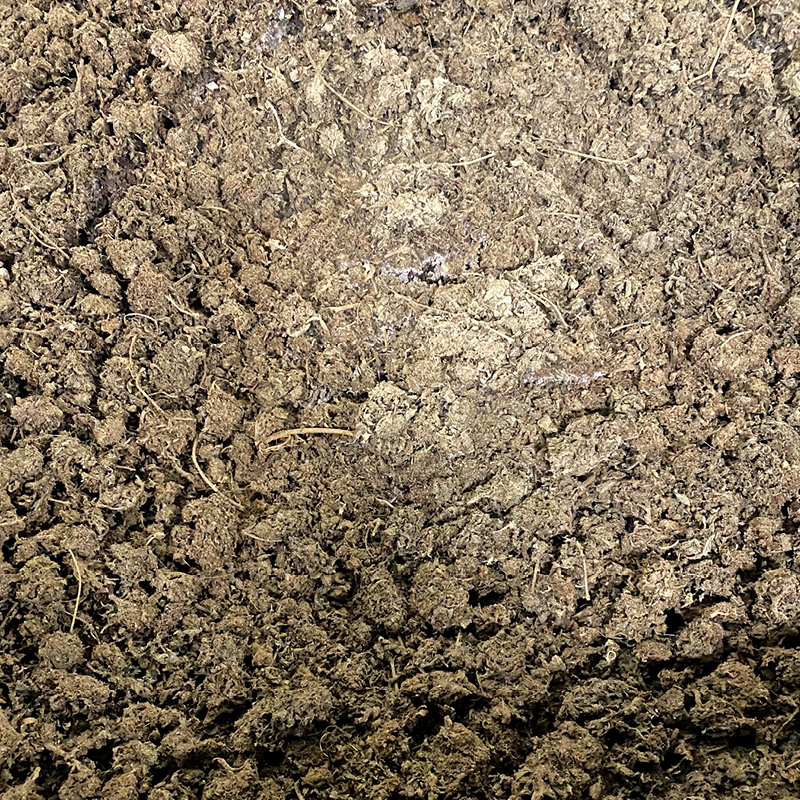Top: A 20-foot Earth Flow in-vessel composting unit in the Enso Solutions’ warehouse.
Nora Goldstein
The state of Oklahoma legalized medical use of marijuana in 2018; laws regulating management of cannabis waste went into effect in November 2019. To collect and/or process the waste from growers, processors, test labs, and dispensaries, companies need to obtain a license from the Oklahoma Medical Marijuana Authority (OMMA), along with a permit from the Oklahoma Department of Environmental Quality (OK DEQ).
Matt Golladay and Nick Mesigh, who are in Oklahoma City, were interested in business opportunities related to the legalization of medical marijuana. There were a limited number of licenses available from OMMA to handle the cannabis waste. “We thought the waste side of this new industry was an interesting way to get involved,” explains Golladay. “In January 2020, our team put together the business plan for a marijuana waste collection and composting company, Enso Solutions. We were permitted by OK DEQ in March 2020, licensed by OMMA in April and became operational in May.”

Chipped trees from a local landscaping company are mixed in with shredded cannabis stems and stalks and loaded into the composter. Photos courtesy of Enso Solutions
Cannabis waste is collected primarily in 96-gallon carts, and transported in a box truck with a lift gate. The company name, Enso, is a Zen Buddhist term that means circle or circular form, says Golladay. “For our company, Enso represents the life cycle of the plants — from earth-to-earth — and composting is our place in that process. We anticipate, once we get our recipes honed, donating or selling compost back to the community.”
Composting Cannabis
While researching composting options, Golladay came across the Earth Flow in-vessel system manufactured by Green Mountain Technologies (GMT). Enso Solutions wanted an industrial-sized, in-vessel system that could be housed in a warehouse in an urban location. “We did some market studies and learned that processors generate thousands of pounds of waste a month,” notes Mesigh. “For example, when processing 1,000 lbs of marijuana trim and flowers, 80% to 95% of the original weight becomes waste. We needed an in-vessel system that could accommodate that volume on a continuous feed basis at a high-rate. The Earth Flow we purchased is a 20-foot refurbished shipping container that can handle about 0.7 tons/day — roughly 1,400 lbs give or take — with a retention time of 14 to 17 days.”
He adds that being first-time composters, the more automated process controls are helpful. “The Earth Flow is equipped with an auger mixer, and has a built-in hydration system,” says Mesigh. “Data on the feedstock mix is entered into a spreadsheet, which calculates the necessary moisture to be added to the material just loaded into the vessel. We worked with Van Calvez of GMT who evaluated the various marijuana waste feedstocks we encounter depending on the generator. He determined the needed recipes and moisture to optimize the composting process.”
Oklahoma City is in central Oklahoma, enabling Enso Solutions to service growers, processors, test labs and dispensaries anywhere in the state. Key to their early success is a thorough understanding of the rules and regulations for handling cannabis waste, starting with rendering the material unusable and unrecognizable when it gets to Enso’s facility. “We shred the waste down to 1- to 2-inches and mix it with wood chips and other feedstocks,” says Golladay. “Our permit requires us to have it loaded into the composter within 48 hours. Some of the waste is already shredded when we pick it up.”
Their 8,290 sq. ft. enclosed warehouse has a concrete floor that enables Enso Solutions to have different curing areas for the compost. The vessel is emptied on an as needed basis, which is about once a week. OMMA does not require the end product to be tested for THC content, but Golladay and Mesigh wanted to test the compost. “The total THC was 0.02%, which is below the level of THC inactivation for Oklahoma and other states,” adds Golladay. Oklahoma has a regulatory target level of less than 0.3% THC. The starting level in the cannabis waste, based on Enso having lab analyses done on 5 different samples, is above 3.0% THC.
The company also had its compost tested for nutrient content. The results, on a dry weight basis, are: total nitrogen, (N) 3.49%; phosphate, 3.28%; potassium, 5.73%; organic matter, 70.92%; and electrical conductivity, 12.6. The nutrient index was >10, which according to Midwest Laboratories, Inc. (the lab conducting the tests), is beneficial for all soils. “When the feedstock for the compost is one of the most well cared for plants, it is bound to make beautiful compost,” says Mesigh.
Compost is screened using a homemade unit. A local park is interested in using the compost for landscape applications. Eventually, local parks and businesses are a targeted end market. “Our goal is to enable these targeted markets to use the recycled waste to add to the beautification of the state, thus completing the circle or Enso,” notes Golladay.















